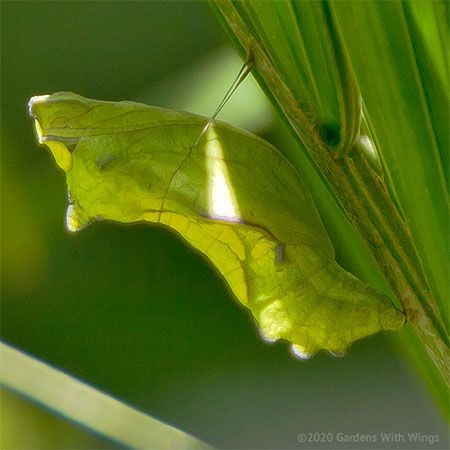
Have you ever wondered what is happening inside a butterfly chrysalis? It’s far more than just a pretty shell! Let’s peek inside and uncover some amazing facts:
- Busy Bees Inside: Forget the idea of a quiet rest! Inside, a complete change is happening. The caterpillar’s body is being broken down and rebuilt into the magnificent butterfly form. It’s a period of intense activity, a true hidden transformation.
- Masters of Disguise: Chrysalises are well-camouflaged, blending seamlessly into their surroundings. They’re experts at mimicking leaves, twigs, or bark to stay safe from predators. You might walk right past one without noticing!
- Winter Warriors: Many butterfly species are true survivalists, spending winter snug inside their chrysalis. They’re built to withstand cold, wind, and even snow – waiting for spring’s warmth.
- No Two Alike: Forget cookie-cutter shapes! Chrysalises come in a variety of sizes, shapes, and colors, depending on the butterfly species. Some are smooth, others are bumpy, and they can be green, brown, or even sport a metallic sheen.
- Sensing the World: Imagine being able to tell when the weather’s changing while tucked away! Some chrysalises can sense shifts in light and temperature, helping them time their grand entrance for the perfect conditions.
- Breathing Easy (Even Inside): They might look sealed up, but chrysalises need to breathe. They have tiny openings called spiracles that allow for essential air exchange. Nature’s design is truly ingenious.
- Silk Stronger Than Steel (Almost!): That silk the caterpillar spins? It’s incredibly strong and resilient, creating a fortress of protection for the developing butterfly. Think of it as nature’s own armor.”
- Secret Sounds in the Shell: Did you know some butterflies, like the viceroy, can make clicking sounds inside their chrysalis? Scientists believe this might be a clever way to deter hungry predators.
- Color-Changing Clues: Some chrysalises can actually change color as the butterfly develops, kind of like a signal that it’s almost ready to emerge. It could also be a way to warn predators or regulate their temperature.
- Unexpected Hideaways: While plants are a common spot, chrysalises can be found in surprising places – on fences, walls, rocks, and even garden furniture. Some caterpillars are quite the travelers in search of the perfect pupation spot.
- A Meal for Some: Despite their camouflage, chrysalises are still a food source for some birds, insects, and small mammals. Nature’s circle continues.
- A Swift Metamorphosis (Relatively Speaking): While it might seem like an eternity, the actual transformation inside often happens remarkably quickly, sometimes in just a couple of weeks. Talk about a rapid makeover!
- A Peek Inside: You can see the butterfly’s wings developing inside a translucent chrysalis for some species, especially close to emergence. It’s like a sneak peek at nature’s masterpiece.
- Light as a Feather, Strong as a Shield: Chrysalises are remarkably lightweight, allowing them to stay attached to plants without causing them to droop and strong enough to protect themselves.
- Not a Cocoon: A common misconception! Butterflies form chrysalises, while moths spin cocoons. Learn more about their difference.
- A Symbol of Hope and Renewal: The chrysalis represents transformation, rebirth, and the potential for beautiful things to emerge after a period of stillness. A true testament to nature’s magic.
- The Grand Finale: Emergence: The final act is the breathtaking emergence of the butterfly, a truly awe-inspiring event that marks the completion of its incredible journey.






